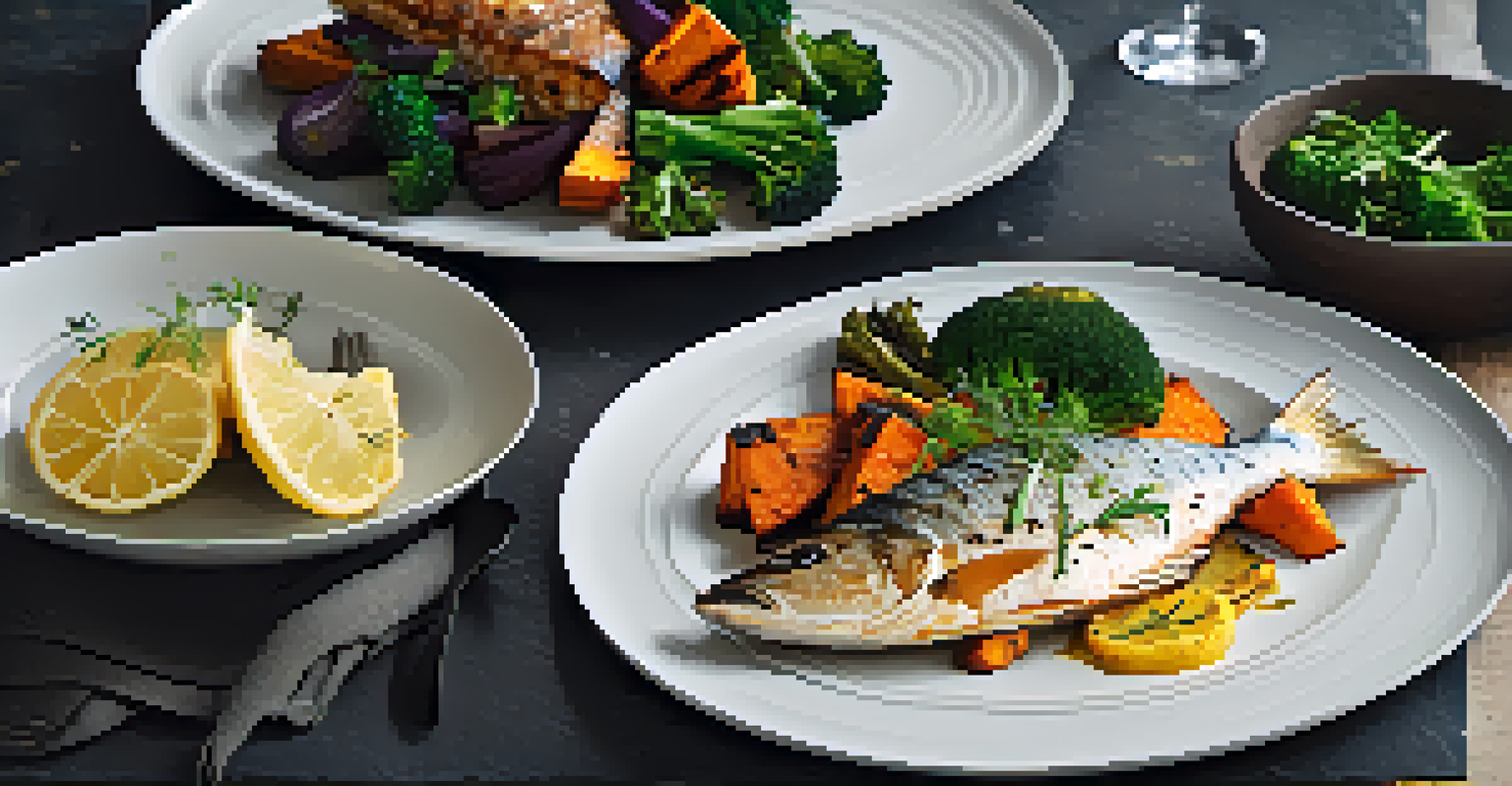Nutritional Myths: Raw vs. Cooked Foods Debunked and Discussed

Understanding Raw Foods: Benefits and Misconceptions
Raw foods have gained popularity due to their perceived health benefits, often believed to retain more nutrients than cooked options. Many proponents argue that cooking diminishes vitamins and enzymes, which are crucial for our health. However, it's essential to recognize that not all raw foods are inherently healthier; the digestibility and nutrient absorption can vary significantly.
Let food be thy medicine and medicine be thy food.
For example, while raw spinach is packed with nutrients, it contains oxalic acid, which can inhibit calcium absorption. Cooking spinach reduces this compound, making the nutrients more accessible to our bodies. This is a classic case of how cooking can enhance the nutritional profile of certain foods, challenging the notion that raw is always best.
In essence, the raw food diet can offer benefits, but it's not a one-size-fits-all solution. Individual needs, digestive health, and personal preferences should guide our choices. Understanding these nuances helps debunk the myth that raw foods are universally superior.
The Nutritional Value of Cooked Foods: A Closer Look
Cooking food can often unlock its nutritional potential, making it more digestible and safe to eat. For instance, cooking tomatoes increases the availability of lycopene, an antioxidant linked to numerous health benefits. This transformation highlights the importance of cooking techniques and how they can enhance the health properties of certain foods.

Moreover, some foods are harmful when consumed raw. For example, legumes and certain cruciferous vegetables contain compounds that can cause digestive issues or even toxicity if not cooked properly. This reinforces the idea that cooking can play a vital role in food safety and nutrient availability.
Raw vs. Cooked: Nutritional Balance
A balanced diet that includes both raw and cooked foods can provide a broader range of nutrients and health benefits.
Ultimately, cooked foods can offer substantial health benefits, and the idea that they are less nutritious than raw options is an oversimplification. A balanced diet that includes both raw and cooked foods can provide a broader range of nutrients, supporting overall health and wellness.
The Myth of Enzymes: Raw Foods vs. Cooking
A common belief in the raw food community is that cooking destroys enzymes vital for digestion and health. While it's true that cooking can deactivate some enzymes, our bodies produce their own digestive enzymes, which are more than capable of handling cooked foods. This means that the enzyme argument is often overstated and can lead people to overlook the benefits of cooked meals.
The greatest wealth is health.
For instance, the enzyme amylase, which helps break down carbohydrates, is plentiful in our saliva and pancreas. So, while raw fruits and vegetables may offer enzymes, the human digestive system is well-equipped to process cooked foods without issue. This can be a game-changer for those feeling guilty about choosing cooked options over raw.
In summary, while raw foods can have their place in a healthy diet, the myth surrounding enzymes should not dictate our food choices. Embracing a variety of food preparations—including cooking—can lead to a more balanced and enjoyable eating experience.
Antioxidants: Raw vs. Cooked Foods Comparison
Antioxidants are often touted as health superheroes, protecting our bodies from damage caused by free radicals. Interestingly, the levels of antioxidants in fruits and vegetables can vary depending on whether they are raw or cooked. For example, cooking carrots increases their beta-carotene content, making it easier for our bodies to absorb this important antioxidant.
On the flip side, some delicate vitamins like vitamin C may diminish with heat. This has led to the belief that raw foods are always the best source of antioxidants. However, this perspective overlooks the fact that certain cooking methods, like steaming or sautéing, can preserve or even enhance antioxidant levels.
Myths About Food Preparation
Common misconceptions about raw foods often overlook the safety and nutritional advantages of cooking certain ingredients.
Ultimately, it's about balance. Including a mix of raw and cooked foods in your diet can provide a diverse array of antioxidants, ensuring you reap the benefits of both. This understanding helps dismantle the myth that one preparation method is superior to the other.
Digestibility: Raw and Cooked Foods Explored
One of the most significant factors influencing our food choices is digestibility. Some foods are easier to digest when cooked, as heat breaks down tough cell walls and fibers. For example, cooking broccoli can soften its fibers, making it less harsh on the digestive system, especially for those with sensitive stomachs.
Conversely, some people may find raw foods easier to digest due to their high water content and natural enzymes. However, this varies from person to person, as individual digestive health plays a crucial role in how well we tolerate different food preparations. This variability suggests that there's no one-size-fits-all approach to raw versus cooked foods.
Ultimately, understanding your body’s unique responses can guide you in making informed choices. Experimenting with both raw and cooked options can help identify what works best for your digestion and overall well-being.
Nutritional Myths Surrounding Specific Foods
Certain foods are often at the center of debates regarding raw versus cooked, leading to common misconceptions. For instance, the idea that raw eggs are more nutritious than cooked eggs is a classic myth. In reality, cooking eggs makes the protein more bioavailable and reduces the risk of salmonella, making them safer and easier to digest.
Similarly, the belief that raw fish is always healthier than cooked fish can be misleading. Raw fish can carry parasites and bacteria, while cooking fish can enhance the absorption of omega-3 fatty acids, which are essential for heart health. This demonstrates the need to evaluate food safety alongside nutritional value.
Cultural Influences on Food Choices
Cultural beliefs shape our understanding of raw and cooked foods, highlighting the importance of knowledge in food preparation.
By addressing these myths, we can make more informed choices about our diets. It's essential to look beyond common beliefs and consider the science behind food preparation to ensure we’re optimizing our nutrition.
Cultural Perspectives on Raw and Cooked Foods
Cultural beliefs and practices heavily influence our views on raw and cooked foods. In some cultures, raw foods are celebrated as a way to connect with nature and promote health, while others emphasize the importance of cooking for safety and flavor. These differing perspectives can shape our understanding of nutrition and impact our food choices.
For example, sushi represents a cultural appreciation for raw fish, showcasing its delicacy and flavor. However, it is prepared with strict guidelines to ensure freshness and safety, highlighting the importance of knowledge in food preparation. This reflects how cultural practices can both promote and challenge common myths about food.

Understanding these cultural contexts can enrich our culinary experiences and help us appreciate the diverse ways in which people approach nutrition. This awareness encourages a more open-minded perspective on the raw versus cooked debate.
Finding Balance: Incorporating Both Raw and Cooked Foods
Ultimately, the discussion around raw versus cooked foods shouldn't be about choosing one over the other. Instead, it's about finding a balance that works for your lifestyle and health needs. Including both raw and cooked foods in your diet can provide a variety of nutrients and culinary experiences.
For instance, a refreshing salad loaded with raw veggies can be a perfect accompaniment to a warm, cooked quinoa dish. This combination allows for the enjoyment of diverse textures and flavors while maximizing nutrient intake. It’s all about creating meals that are not only healthy but also enjoyable.
Balance Raw and Cooked Foods
Incorporating both raw and cooked foods can provide a variety of nutrients and enhance overall health.
By embracing both raw and cooked foods, you can cultivate a more flexible and satisfying diet. This balanced approach helps dismantle the myths surrounding food preparation and encourages a mindset focused on overall health and well-being.